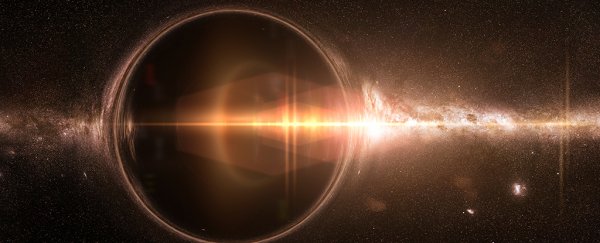Hawking radiation describes hypothetical particles formed by a black hole's boundary. This radiation implies black holes have temperatures that are inversely proportional to their mass.
Putting it another way, the smaller a black hole is, the hotter it should glow.
Although it has never been directly observed, Hawking radiation is a prediction supported by combined models of general relativity and quantum mechanics. It is named after the eminent physicist Stephen Hawking, who, in 1974, published a paper titled Black hole explosions? arguing for their existence.
If shown to be factual, Hawking radiation would mean black holes can emit energy and therefore shrink in size, with the tiniest of these insanely dense objects exploding rapidly in a puff of heat (and the largest slowly evaporating over trillions of years in a cold breeze).
Why should black holes glow?
Whenever matter enters a black hole, it is effectively locked away from the rest of the Universe. This also removes a measure of disorder; a characteristic physicists call entropy.
Since this removal of matter leaves the Universe less disordered, it was thought to break the second law of thermodynamics.
A physics student from Princeston in the US named Jacob Bekenstein pointed out that the boundary surrounding the space most affected by a black hole's insane gravity – a 'surface' called an event horizon – should increase in area whenever matter falls in.
He showed how this area represents the measure of entropy that would otherwise be lost, a suggestion that should solve the paradox.
Hawking wasn't so sure. Entropy is another way of describing heat energy, which necessarily emits radiation. If an event horizon has entropy, it should glow in some way, meaning black holes wouldn't be so black after all.
In his efforts to disprove Bekenstein's seemingly absurd suggestion, Hawking discussed it with other physicists and attempted to show using mathematical models it wasn't possible.
Instead, he discovered black holes really do seem to shine with cold light.
How do black holes produce Hawking radiation?
The physical process behind the emission of particles from near a black hole's event horizon is fairly complex, relying on a solid understanding of the mathematics of quantum field theory.
It's commonly described as the result of twin 'virtual' particles that naturally emerge from the vacuum being separated by gravity. Usually they would recombine and cancel out, but in this case the split leaves one half of every pair to escape as actual radiation.
In fact, Hawking's own popular explanation of the mathematics describes fleeting virtual particles affected by extreme gravity, with one half of the pair removing mass from the black hole thanks to extreme gravity providing the particle with negative energy.
Other physicists feel this 'localised' description of particles splitting apart over an imaginary line is a touch misleading.
While we'd need a complete theory of gravity's role in quantum mechanics to map this interaction properly, Hawking's conclusions show how curved space can upset the mix of quantum properties in the fields near an event horizon, to the point that black holes 'scatter' some features while leaving others intact. It's these intact properties that resemble specific temperatures of radiation, and can cause a black hole to shrink.
All topic-based articles are determined by fact checkers to be correct and relevant at the time of publishing. Text and images may be altered, removed, or added to as an editorial decision to keep information current.
